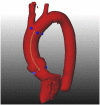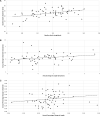Ascending thoracic aortic aneurysm elongation occurs in parallel with dilatation in a nonsurgical population
- PMID: 37354525
- PMCID: PMC10301688
- DOI: 10.1093/ejcts/ezad241
Ascending thoracic aortic aneurysm elongation occurs in parallel with dilatation in a nonsurgical population
Abstract
Objectives: Rapid diameter growth is a criterion for ascending thoracic aortic aneurysm repair; however, there are sparse data on aneurysm elongation rate. The purpose of this study was to assess aortic elongation rates in nonsyndromic, nonsurgical aneurysms to understand length dynamics and correlate with aortic diameter over time.
Methods: Patients with <5.5-cm aneurysms and computed tomography angiography imaging at baseline and 3-5 years follow-up underwent patient-specific three-dimensional aneurysm reconstruction using MeVisLab. Aortic length was measured along the vessel centreline between the annulus and aortic arch. Maximum aneurysm diameter was determined from imaging in a plane normal to the vessel centreline. Average rates of aneurysm growth were evaluated using the longest available follow-up.
Results: Over the follow-up period, the mean aortic length for 67 identified patients increased from 118.2 (95% confidence interval: 115.4-121.1) mm to 120.2 (117.3-123.0) mm (P = 0.02) and 15 patients (22%) experienced a change in length of ≥5% from baseline. The mean annual growth rate for length [0.38 (95% confidence interval: 0.11-0.65) mm/year] was correlated with annual growth rate for diameter [0.1 (0.03-0.2) mm/year] (rho = 0.30, P = 0.01). Additionally, annual percentage change in length [0.3 (0.1-0.5)%/year] was similar to percentage change in diameter [0.2 (0.007-0.4)%/year, P = 0.95].
Conclusions: Aortic length increases in parallel with aortic diameter at a similar percentage rate. Further work is needed to identify whether elongation rate is associated with dissection risk. Such studies may provide insight into why patients with aortic diameters smaller than surgical guidelines continue to experience dissection events.
Keywords: Aortic aneurysms; Aortic diameter; Aortic elongation; Type A dissection.
Published by Oxford University Press on behalf of the European Association for Cardio-Thoracic Surgery 2023.
Figures





References
-
- McClure RS, Brogly SB, Lajkosz K, Payne D, Hall SF, Johnson AP.. Epidemiology and management of thoracic aortic dissections and thoracic aortic aneurysms in Ontario, Canada: a population-based study. J Thorac Cardiovasc Surg 2018;155:2254–64.e4. - PubMed
-
- Pape LA, Tsai TT, Isselbacher EM, Oh JK, O'gara PT, Evangelista A. et al.; International Registry of Acute Aortic Dissection (IRAD) Investigators. aortic diameter ≥5.5 cm is not a good predictor of type A aortic dissection. Circulation 2007;116:1120–7. - PubMed
-
- Erbel R, Aboyans V, Boileau C, Bossone E, Di Bartolomeo R, Eggebrecht H. et al. 2014 ESC Guidelines on the diagnosis and treatment of aortic diseases: document covering acute and chronic aortic diseases of the thoracic and abdominal aorta of the adult. The Task Force for the Diagnosis and Treatment of Aortic Diseases of the European Society of Cardiology (ESC). Eur Heart J 2014;35:2873–926. - PubMed
-
- Hiratzka LF, Bakris GL, Beckman JA, Bersin RM, Carr VF, Casey DE Jr. et al. 2010 ACCF/AHA/AATS/ACR/ASA/SCA/SCAI/SIR/STS/SVM guidelines for the diagnosis and management of patients with Thoracic Aortic Disease: a report of the American College of Cardiology Foundation/American Heart Association Task Force on Practice Guidelines, American Association for Thoracic Surgery, American College of Radiology, American Stroke Association, Society of Cardiovascular Anesthesiologists, Society for Cardiovascular Angiography and Interventions, Society of Interventional Radiology, Society of Thoracic Surgeons, and Society for Vascular Medicine. Circulation 2010;121:e266–369. - PubMed

